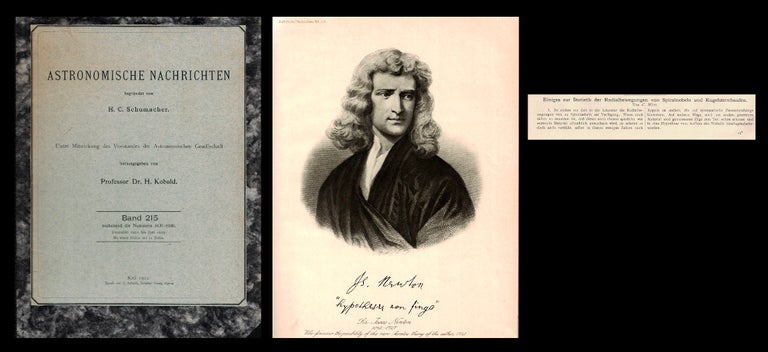Einiges zur Statistik der Radialbewegungen von Spiralnebeln und Kugelsternhaufen in Astronomiche Nachrichten 215, 349-354, 1921
Kiel: C. Schmidt, 1921. 1st Edition. FIRST EDITION OF WIRTZ’S 1921 STUDY OF THE BRIGHTNESS & DOPPLER SHIFT OF A NUMBER OF SPIRAL NEBULAE, HERE – 8 YEARS BEFORE HUBBLE -- PRESENTING THE FIRST SUGGESTION OF A LINEAR RELATIONSHIP BETWEEN VELOCITY AND APPARENT MAGNITUDE. In this paper, the title of which translates as “Statistics of the Radial Movements of Spiral Nebulae and Globular Clusters”, Wirtz “found a correlation of radial velocity with the magnitude of the object, in the sense that the fainter the spiral, the larger its radial velocity tended to be” (Bertotti, Modern Cosmology, 275). In 1929, Hubble unequivocally confirmed Wirtz’s argument that “the more distant a galaxy is, the faster it moves away from us” (Stott, Images of the Universe, 17).
Carl Wilhelm Wirtz (1876-1939), the Observator (i.e. the principle observer) of the Kiel Observatory studied the radial velocities of spiral nebulae. “He concluded in 1918 that the distances of these spiral nebulae, though wrongly evaluated to 21000 light years, are located outside the Milky Way and that the system of spiral nebulae expands with 656 km/s in relation to the solar system” (Gesellschaft, Panchromatic View of Galaxies, ii).
As he searched further for correlations between the velocities of the spiral galaxies and other observable properties, Wirtz analyzed the brightness and Doppler shift of a number of spiral nebulae. In 1921, Wirtz combined the 1911 Slipher redshift measurements (which allowed for 15 systems) with distances based on the apparent diameters of galaxies, and was able to expand Slipher’s number to 29, solving for solar motion. “With this large number of objects, he found an even larger value of the K term… so much larger than its probable error that it ‘could not be disregarded’” (Bertotti).
Wirtz concluded that, when the data were averaged in a suitable way, “…an approximate linear dependence of velocity upon apparent magnitude is visible” (Czerny, Astronomy and Astrophysics, 40). “His specific proposal was ‘a change of 200 km/sec in velocity implies a change of one magnitude of brightness’ (History of Physics: The Wenner Collection).
Following his 1929 confirmation of Wirtz’s findings, in 1934 “Hubble was in a position to formulate a velocity-distance relation which has since become known as Hubble’s law, although over the years its numerical value has been modified in the light of later evidence; its basic principle is not, however, in question. We live in an expanding universe” (Stott). Item #1027
CONDITION & DETAILS: Kiel: C. Schmidt. 4to. (11.25 x 9.25 inches). Complete volume (Band) 215. Frontispiece (Isaac Newton) and 10 plates. [6], 483, [2]. This is not an ex-institutional copy. A handsome volume, tightly and solidly bound in black cloth over marbled paper boards. Old handwritten paper spine label partially removed, prior owner's name on front free endpaper. Some toning to the prelims. Bright and clean inside and out. Near fine.
Price: $575.00

